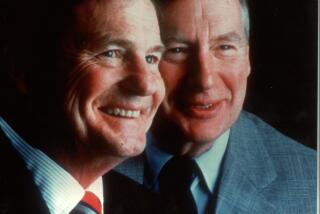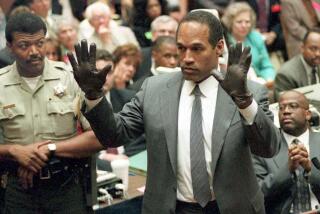‘The Big News’ was big news in broadcast world
An apt title for the typical TV newscast of the 1950s might have been: “Inaction News!”
There simply wasn’t much of it on the tube back in those pre-Lindsay Lohan days.
In Southern California, for instance, the nightly fare on KNXT-TV (Channel 2) in 1959 consisted of a network newscast from 7:15 to 7:30, and two local newscasts from 7 to 7:15 and 11 to 11:15. Yup, 30 minutes of local news nightly, two-thirds of which was devoted to sports and weather.
TV anchors would sometimes introduce stories by holding up the morning’s newspaper headlines.
So there was some astonishment in 1961 when KNXT (now CBS2) introduced “The Big News,” billed as the first 45-minute newscast in the nation.
“People said, ‘How are you ever going to fill it?’ ” recalled Pete Noyes, the show’s city editor and, later, producer.
It wasn’t difficult for Noyes. A former wire service newsman, he brought an investigator’s zeal to the job of ferreting out corruption and fraud. He also developed numerous sources in law enforcement and scored scoops in such cases as the Manson family murders.
Creator Sam Zelman put together a talented staff, including anchor Jerry Dunphy, a Chicago import with a stentorian baritone; investigative reporter Maury Green; avuncular Ralph Story; witty weatherman Bill Keene; and actor/umpire-turned-sportscaster Gil Stratton.
KNXT set up bureaus in Sacramento and throughout the state as well as in Washington, D.C.
The ratings soared, though the pace was stressful. The staff worked in “a somewhat dingy one-story building abandoned by the Bank of America,” Noyes wrote in his colorful memoir, “The Real Los Angeles Confidential.”
“There were bottles of booze in the desks of several writers and producers. The smell of burning trash cans resulted from discarded cigarettes that were still lit.”
After one heated exchange with the sometimes-imperious Dunphy, Noyes took a wild swing at the anchorman, knocking over his podium and water glass. Noyes wasn’t fired, only kidded by a superior about missing with his punch.
Ramping up the tension, KNXT expanded “The Big News” to an hour in 1963. Noyes recalled that he “fell into” being producer on the first day because one candidate phoned in sick and the other left to mull things over at a local bar.
News executives from other cities visited to see how to set up a one-hour newscast.
Noyes won the Edward R. Murrow Award for his scoop about the arrests in the Manson case. Noyes and a sergeant in the Sheriff’s Department had discovered similarities between a previous murder involving the gang and the Tate-La Bianca murders.
Noyes’ three-man crew, dressed as pheasant hunters at the request of the local district attorney, broke the news of the family’s arrests in an Inyo County hideout.
Some of Noyes’ stories were amusing, as when he learned that Los Angeles Police Chief William Parker wanted to transfer the duties of school crossing guards to his officers because his crossing-guard mother would not retire.
“Bill’s not going to get away with this,” she told Noyes, and she was correct. Parker abandoned his plan when it became public.
“The Big News” left its imprint on the entertainment world too.
The treasurer of KNXT was the aunt of actress Mary Tyler Moore and regaled her “with stories of those strange people who populated the newsroom,” Noyes wrote.
Thus was born a sitcom set in a TV newsroom, “The Mary Tyler Moore Show.”
Noyes was the model for crusty Lou Grant, while Dunphy was one of the inspirations for bombastic anchor Ted Baxter.
In the early episodes, Grant had a bottle of booze in his desk, which upset Noyes’ mother. Noyes persuaded the writers to eliminate it from the script.
Back in the real, or mostly real, world other local stations had beefed up their newscasts. Stations turned to consultants and market researchers for story ideas. Shorter, glitzier pieces were emphasized.
Dunphy was shown the door in 1975 and moved to KABC-TV (Channel 7), which promptly rose to the top of the ratings while KNXT plummeted. “The Big News” was no more.
By then Noyes was gone too. He had gotten the ax in 1972, told by a new boss that, at 42, he was too old to produce the show.
He went on to work as a producer at other stations for the next 36 years.
At KABC-TV, he won a Peabody, television’s highest broadcasting award, for an expose about a flimflam man who tricked backers into investing in a revolutionary three-wheeled car that would get 75 miles per gallon (the most revolutionary part of it was that it didn’t exist).
Now 80, and working on a book about “Black Dahlia” murder victim Elizabeth Short, Noyes has also piled up a total of 10 Emmys and 17 Golden Mikes.
And he has never swung at another anchorman, though, he grumbled, “I’ve thought about it.”
More to Read
Start your day right
Sign up for Essential California for news, features and recommendations from the L.A. Times and beyond in your inbox six days a week.
You may occasionally receive promotional content from the Los Angeles Times.






